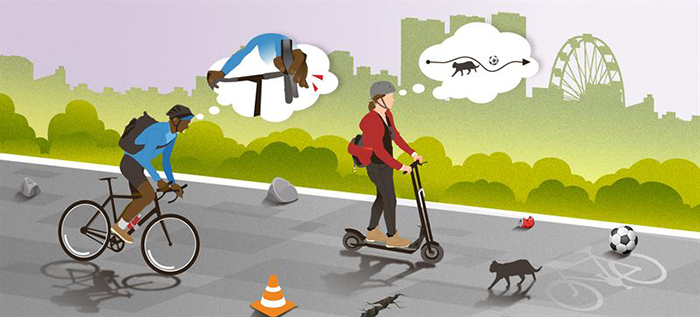E-scooters have become a familiar sight in cities worldwide in recent years, with many new companies renting them for use. But their arrival has also brought new safety concerns. Now, researchers from Chalmers University of Technology, Sweden, present a framework for comparing how different micromobility vehicles, such as e-scooters, and bicycles move in cities, a methodology that can benefit companies and local authorities alike, and—most importantly—contribute to improving traffic safety.
In recent years, e-scooters have proliferated in cities worldwide, offering citizens a novel and convenient way to get around, but their arrival has not been frictionless. Commonly voiced concerns are that e-scooter riders break traffic rules, ride too fast, and park inappropriately. Perhaps most concerning is that crash databases, as well as insurance claims, show a clear and disproportionate rise in crashes as the number of e-scooters increases. Local authorities have sought to address these concerns through measures such as speed restrictions, requiring users to wear helmets, designated parking areas, and limiting the number of scooters or operators allowed in the city—or even outright bans.
“E-Scooters are not necessarily more dangerous than bicycles, but they are often perceived as such, possibly because of their unfamiliarity and the behavior of their riders,” explains Marco Dozza, Professor in Active Safety and Road-User Behaviour at Chalmers University of Technology, and lead author of the new study.
“While bicycling benefits from established social norms, regulations, and infrastructure, the same is not true for newer micromobility vehicles, such as e-scooters, Segways, monowheels, electric skateboards and so on. The spread and usage of these vehicles is only likely to increase, so finding ways to safely integrate them in the transport system is a vital and urgent challenge.”
To understand what makes riding new micromobility vehicles unsafe and how that compares to riding a more traditional bicycle, extensive data is needed. Scooter companies already have access to huge amounts of data, because they track every ride using GPS, but the quality of the data tends to only be useful for logistics and mapping services, while providing insufficient information about safety. Hospital admissions data and police reports may help appreciate the size of the safety problem—but cannot explain why crashes happen.
What is missing is a framework for collecting and analysing data to understand what makes rider behavior unsafe and causes the crashes. Now, Marco Dozza and colleagues present exactly this.
Two different strategies: braking or steering away
The researchers outline a process for data-collection in the field and analysis, that is intended to be repeatable and adaptable for different vehicles—from identifying useful test-maneuvers, to measuring and analysing the results of subsequent experiments. In their pilot study, the researchers compared bikes and e-scooters directly, equipping them with measuring instruments and testing the riders on various maneuvers, involving combinations of braking—both planned, and in reaction to a random signal—and steering at different speeds.

COMMENTS